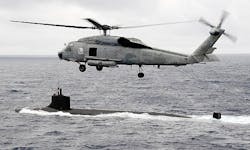L-3 to install critical components of Navy Atlantic underwater warfare training range
Officials of the Training Systems Division of the U.S. Naval Air Warfare Center in Orlando, Fla., are asking L-3 MariPro to install the Ocean Sensor Subsystem (OSS) and the Shore Electronics Subsystem (SES) of the Undersea Warfare Training Range (USWTR) off the coast of Jacksonville, Fla.
The USWTR will help train ship, submarine, and aircraft crews to track targets on the surface and under water. The USWTR, which L-3 MariPro is building about 50 nautical miles east of Jacksonville, Fla., will be a high fidelity underwater tracking and communications range for anti-submarine warfare (ASW) and anti-surface warfare (ASuW) training.
By the time the underwater training range comes online in 2019 it will process and display on-range tracking data for ships, submarines, weapons, targets, and unmanned undersea vehicles (UUVs) to help naval surface and submarine forces plan and carry out attacks on submerged targets that simulate enemy submarines.
The contract modification announced on 23 Nov. calls for L-3 MariPro to install two components of the USWTR. The wet end, or Ocean Sensor Subsystem, The East Coast USWTR will consist of as many as 300 underwater acoustic devices located throughout the 500-square-mile range.
Related: Sonar technology comes to grips with dangerous new era
The OSS also will have more than 600 nautical miles of node cable; two junction boxes; and shore-based display, processing, and control subsystems. The range's dry end, or the shore electronics subsystem, is located on the shore at Jacksonville, Fla., that interfaces with a digital signal processor (DSP).
Some undersea nodes in the OSS ping active sonar signals through the water where other receiver nodes pick them up. The SES detects and time tags the ping signals, which then go to an underwater tracking subsystem that calculates the positions of underwater targets through triangulation.
The OSS consists of hydrophones and other electronics mounted on the ocean bottom throughout the tracking range area that are integrated with a cable system to bring the signals back to the SES on shore. The OSS also will have a projector that act as an underwater telephone to enable operators to communicate with submarines on the range.
story continues below
The SES, meanwhile, serves as the shore termination component for the OSS, providing power to the OSS, and interfaces with the OSS by coaxial or optical cable to receive signals from the hydrophones and transmit signals to the projectors.
Since the SES-to-OSS interface is system-dependent for multiplexed systems the Navy handles procurement of the two subsystems in one contract, Navy officials say.
The USWTR will enable Navy training scenarios ranging from one fixed-wing aircraft or helicopter vs. one submarine; one ship and one helicopter vs. one submarine; one submarine vs. one submarine; and two surface ships and two helicopters vs. one submarine.
Those training on the range will be able to use a variety of practice torpedoes, active and passive sonobuoys, dipping sonar, torpedo sonar, underwater communications, submarine acoustic countermeasures, expendable bathythermographs, and anti-torpedo decoys. Training scenarios can last from two to six hours.
The Navy finished installing ocean cables under the seafloor on the training range last summer. The USWTR ultimately will have a cable termination facility at Mayport Naval Station in Atlantic Beach, Fla., and a range operations center at Jacksonville Naval Air Station in Jacksonville, Fla.
L-3 MariPro initially won a potential $127 million contract in 2012 to design the USWTR. The program's first phase provides the initial infrastructure, including shore facilities and equipment, as well as near-shore cable and sea bed sensors to instrument an area of approximately 200 square nautical miles. The second phase will instrument the remaining 300 square nautical miles.
On the latest contract modification L-3 MariPro will do the work in Goleta, Calif.; Newington, N.H.; and Mayport, Fla., and should be finished by May 2019. For more information contact L-3 MariPro online at www.l-3mps.com/maripro, or the Naval Air Warfare Center Training Systems Division at www.navair.navy.mil/nawctsd.
